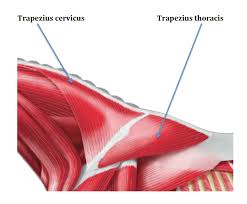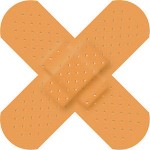Training Philosophies
How to achieve a “soft back”
April 14, 2014 by
We always hear coaches talking about getting our horses to soften and use their backs. There are several sections of the back that the horse can resist from but today we are going to discuss how and why we need access to the base of the neck. It is very important to have this section of the topline soft because without this key section being relaxed the horse can neither lift its shoulders nor connect to its lower back.
The group of muscles that I am talking about are illustrated in the picture below. This triangular group of muscles, when trained properly should appear to reach from the top of the withers and line of the shoulder, all the way up the neck to behind the ears. It should not be fat or thick at the base of the neck. If it is, the horse is holding his neck by pulling it backwards into the shoulder. The correct feeling of the base of the neck being soft can be described as the feeling of the neck “draping” from the withers without resistance.
The horses should reach down and out with its nose and look for the contact, when you have achieved the correct position. This feeling can be obtained through the use of bend, paying particular attention to the way the horse bends its neck where it comes out of the shoulder. To break the initial tension in that area, imagine that when you bend the horse’s neck left, the shoulders will fall out to the right and vice versa.
By removing the tension from the base of the neck, the rider is also in most cases taking tension out of the horse’s lower back. A horse should balance itself through long, relaxed topline muscles. Often the idea of collecting a horse makes the rider think they need to contract the horse’s muscles. This is not the case. Collection should always be achieved through relaxation. Many riders will also endeavour to stretch their horse’s but without ensuring the muscles in front of the withers are soft and long, the exercise is wasted. The same is true for a horse that is low and appearing to stretch but behind the vertical. If the horse’s nose is not open when it is stretching, it will not gain the strength required in the lower back for the higher levels. Obtaining this feeling will allow you to lift the frame through the whole topline, not just bring the neck up leaving the shoulders and back down.
*Please read my article on Toe Flicking to help you understand some of the symptoms of an incorrect connection over the topline.
Allowing your Horse to make Mistakes
December 1, 2013 by
Horses are not all that different from children. In order for a horse to learn, they have to be allowed to make mistakes. If our parents never let us fall down, we never would have learned to walk and later run. When learning multiplication tables, if your a child gets it wrong, you don’t move on to division! It can’t work. It is much the same for horses. If we, as riders are always trying to prevent mistakes, our horses will never learn. We will become responsible for things we shouldn’t be (ie. frame, balance, rhythmn) If this happens we will never be able to ride softly and quietly. We have to allow them to make decisions. They will either make the right choice or the wrong choice. If they make the right choice, Great! The lesson is being learned. If they make the wrong decision, oh well, it just gives us a chance to make a correction and provide the horse another opportunity to learn.

If you feel like you are having to ride really physically all the time, consider how you got there… Have you been accepting responsibility for things you shouldn’t? Are you taking away your horses ability to learn? Let them make mistakes, don’t panic and turn training into a learning process for you both!
Making Appropriate Corrections
October 22, 2013 by
One of the most common mistakes I encounter when teaching happens when riders begin correcting the symptoms of their problems. By this I mean that a rider gets so involved with trying to make everything look perfect, that they lose sight of where the problem actually began.
Imagine you went to the doctor with a compound fracture. The doctor wouldn’t stick a bandage over the bloody bone jutting out of your leg and send you home. That wouldn’t make you any better, it would only make it appear better. It would also lead to all kinds of other symptoms; a limp, infection, pain. He would instead, reset the leg and deal with the source of the problem, the break.

The same idea can be applied to your riding. Let’s say that you are trying to turn down the centre line on the right rein but for some reason every time you try it, your horse ends up two meters off the line, way over flexed to the right and you find yourself in a pretzel like position with your right hand in your lap! What has gone wrong? How did you end up here?
What has happened is that the rider has started slapping Bandaids on the issue and they are not recognizing the source of the problem. The horse isn’t turning, so the rider begins to throw everything they have at the horse in an attempt to improve the situation. It doesn’t work because the rider has missed that this predicament occurred as a result of the horse not responding correctly to the outside aids (turning aids). The proper correction in this case would be to reinforce the outside aids with a kick from the outside leg and a half-halt with the outside rein. This would stop all of the complications seen in the rider’s initial incorrect approach, from ever occurring. Be careful to avoid piling aids on top of aids to fix your problems, it never works! Always try to discover the source of the problem. Continually referring back to your training pyramid will help you with this. If you are having to “muscle” through it, you’re probably heading in the wrong direction.
 As dressage riders we all have this idea that everything has to be beautiful all the time. Well, I’m saying that sometimes you need to “upset the applecart”! Too often we allow our horses to respond incorrectly or not at all to our aids in the pursuit of “pretty”, only to end up compromising our position and therefore our ability to progress within an exercise. Be sure that every aid you apply gets the result it intended. There are few things in dressage training that will take you out at the knees faster than a poorly enforced aid!
As dressage riders we all have this idea that everything has to be beautiful all the time. Well, I’m saying that sometimes you need to “upset the applecart”! Too often we allow our horses to respond incorrectly or not at all to our aids in the pursuit of “pretty”, only to end up compromising our position and therefore our ability to progress within an exercise. Be sure that every aid you apply gets the result it intended. There are few things in dressage training that will take you out at the knees faster than a poorly enforced aid!